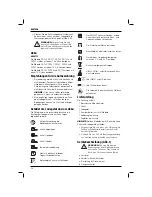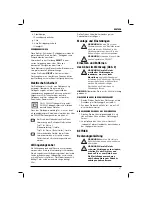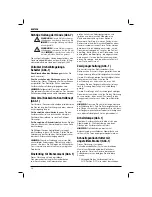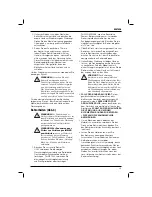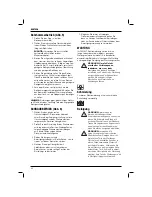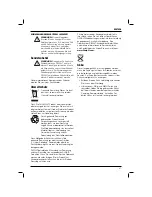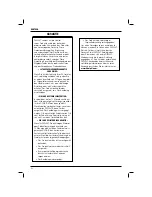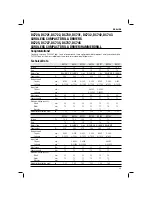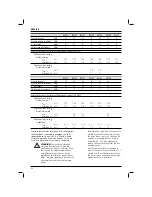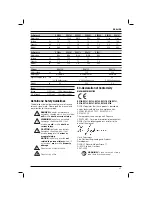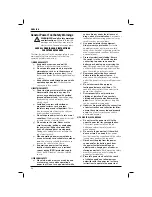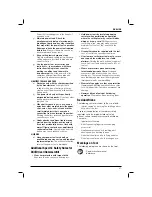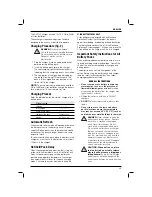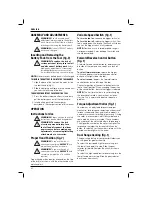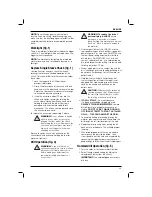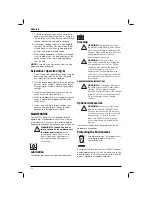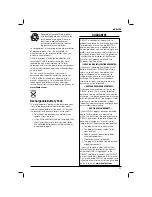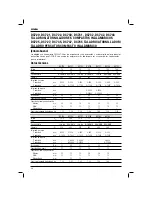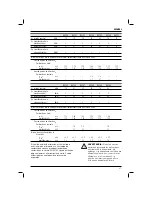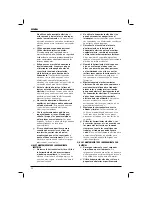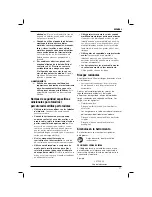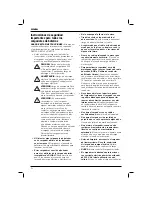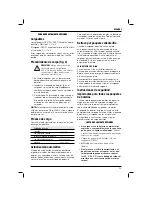
ENGLISH
39
The DE9135 charger accepts 7.2–18 V NiCd, NiMH
or Li-Ion batteries.
These chargers require no adjustment and are
designed to be as easy as possible to operate.
Charging Procedure (fi g. 2)
DANGER:
Electrocution hazard.
230 volts present at charging terminals.
Do not probe with conductive objects.
Danger of electric shock or
electrocution.
1. Plug the charger (j) into an appropriate outlet
before inserting battery pack.
2. Insert the battery pack (g) into the charger.
The red (charging) light will blink continuously
indicating that the charging process has started.
3. The completion of charge will be indicated by
the red light remaining ON continuously. The
pack is fully charged and may be used at this
time or left in the charger.
NOTE:
To ensure maximum performance and life of
NiCd, NiMH and Li-Ion batteries, charge the battery
for a minimum of 10 hours before first use.
Charging Process
Refer the table below for the state of charge of the
battery pack.
State of charge
charging
– – – – – –
fully
charged
–––––––––––
hot/cold pack delay
––– – ––– –
replace battery pack
•••••••••••
problem
•• •• •• ••
Automatic Refresh
The automatic refresh mode will equalise or balance
the individual cells in the battery pack at its peak
capacity. Battery packs should be refreshed weekly
or whenever the pack no longer delivers the same
amount of work.
To refresh your battery pack, place the battery in the
charger as usual. Leave the battery pack for at least
10 hours in the charger.
Hot/Cold Pack Delay
When the charger detects a battery that is too hot
or too cold, it automatically starts a Hot/Cold Pack
Delay, suspending charging until the battery has
reached an appropriate temperature. The charger
then automatically switches to the pack charging
mode. This feature ensures maximum battery life.
LI-ION BATTERY PACKS ONLY
Li-Ion batteries are designed with an Electronic
Protection System that will protect the battery
against overloading, overheating or deep discharge.
The tool will automatically turn off if the Electronic
Protection System engages. If this occurs, place the
Li-Ion battery on the charger until it is fully charged.
Important Safety Instructions for All
Battery Packs
When ordering replacement battery packs, be sure
to include catalog number and voltage. Consult the
chart at the end for compatibility of chargers and
battery packs.
The battery pack is not fully charged out of the
carton. Before using the battery pack and charger,
read the safety instructions below. Then follow
charging procedures outlined.
READ ALL INSTRUCTIONS
• Do not charge or use battery in explosive
atmospheres, such as in the presence of
flammable liquids, gases or dust.
Inserting
or removing the battery from the charger may
ignite the dust or fumes.
• Charge the battery packs only in D
E
WALT
chargers.
• DO NOT
splash or immerse in water or other
liquids.
• Do not store or use the tool and battery
pack in locations where the temperature
may reach or exceed 40˚ C (105° F) (such as
outside sheds or metal buildings in summer).
DANGER:
Never attempt to open the
battery pack for any reason. If battery
pack case is cracked or damaged,
do not insert into charger. Do not
crush, drop or damage battery pack.
Do not use a battery pack or charger
that has received a sharp blow, been
dropped, run over or damaged in any
way (i.e., pierced with a nail, hit with a
hammer, stepped on). Electric shock
or electrocution may result. Damaged
battery packs should be returned to
service center for recycling.
CAUTION: When not in use, place
tool on its side on a stable surface
where it will not cause a tripping or
falling hazard.
Some tools with large
battery packs will stand upright on the
battery pack but may be easily knocked
over.


